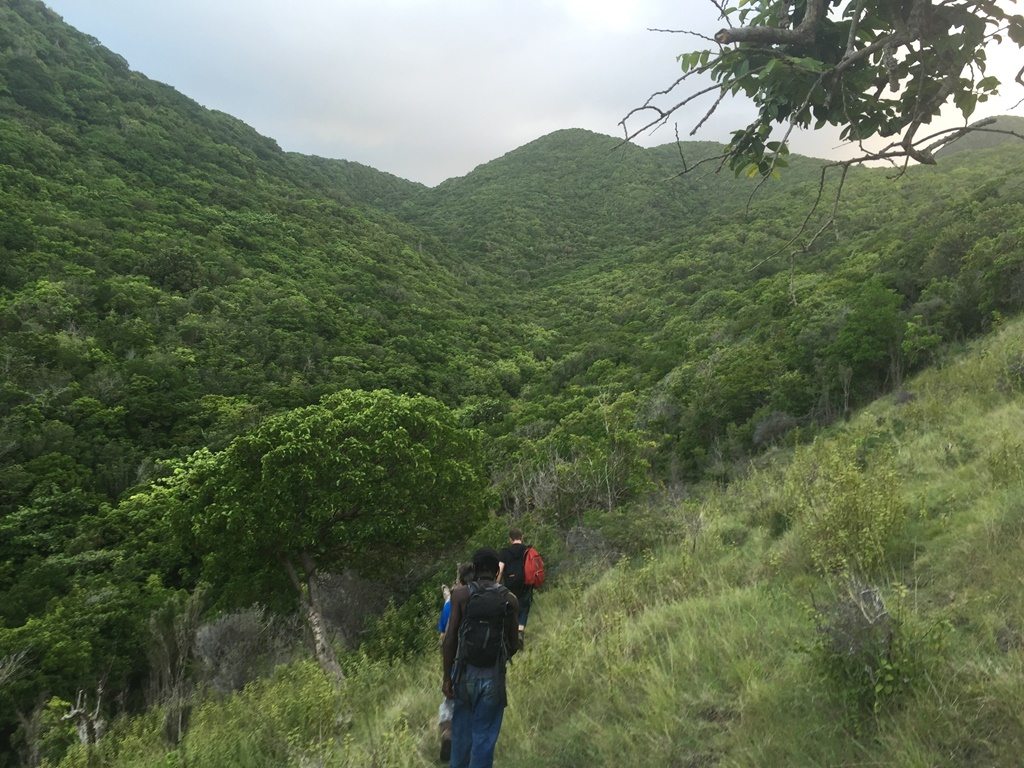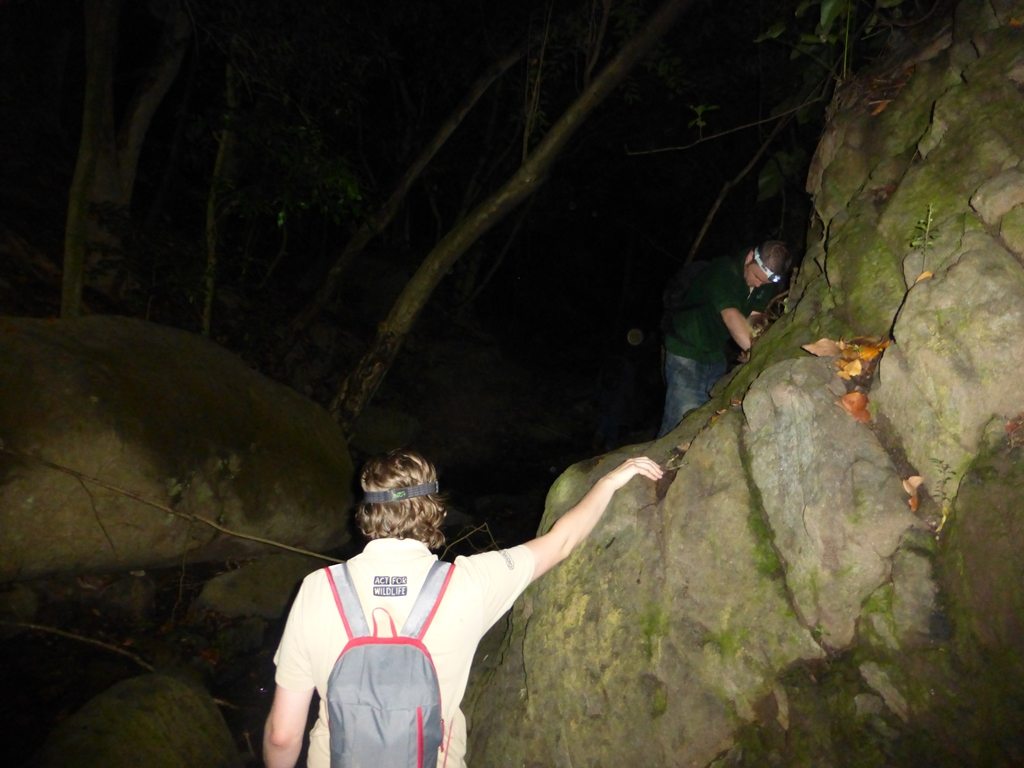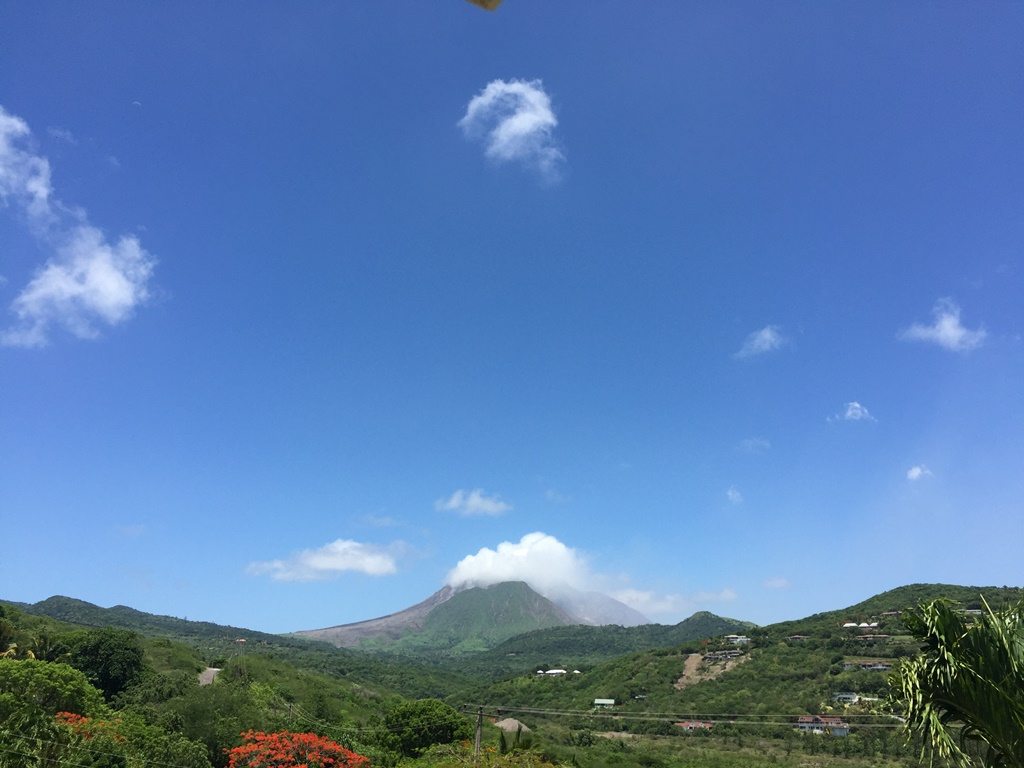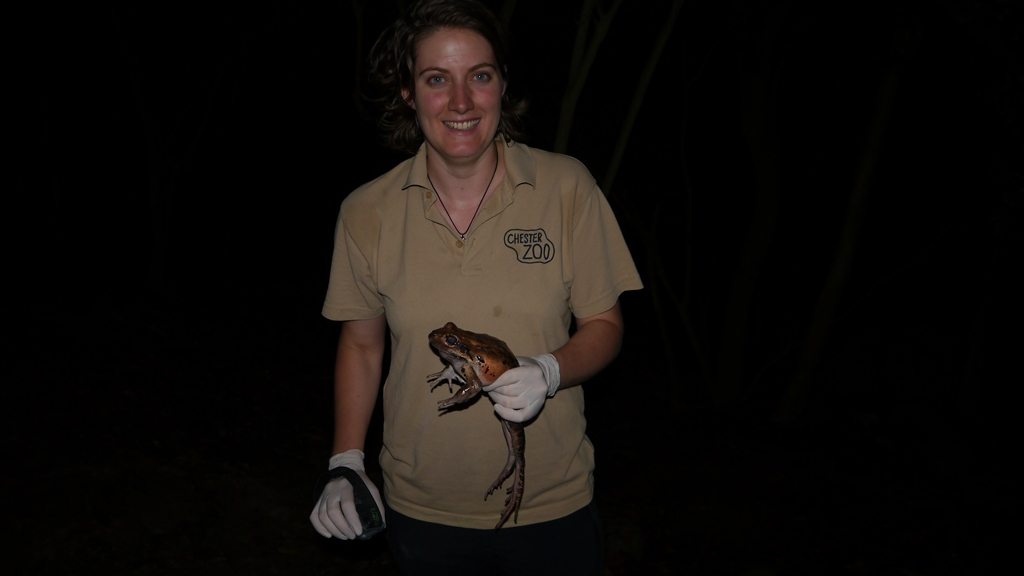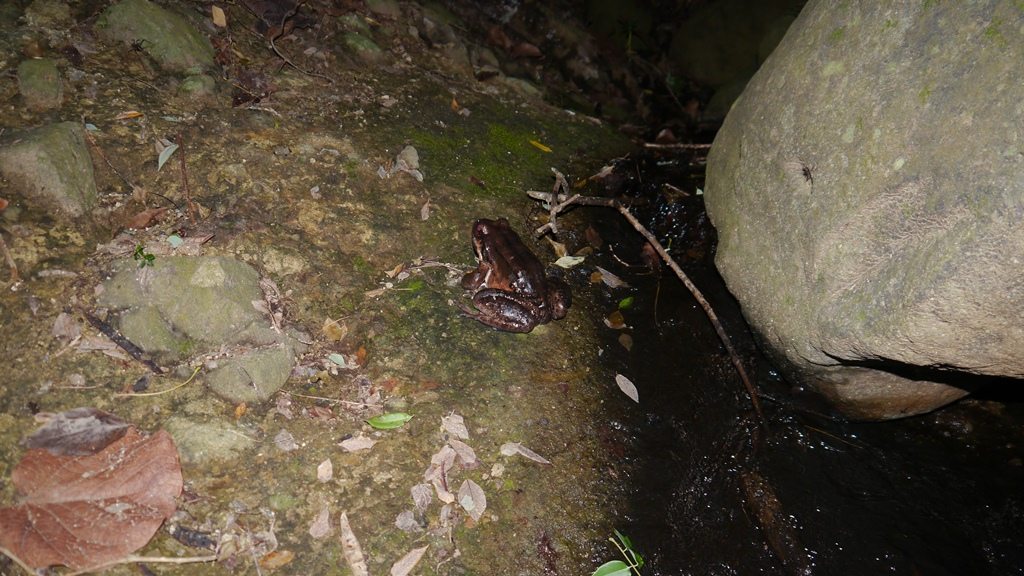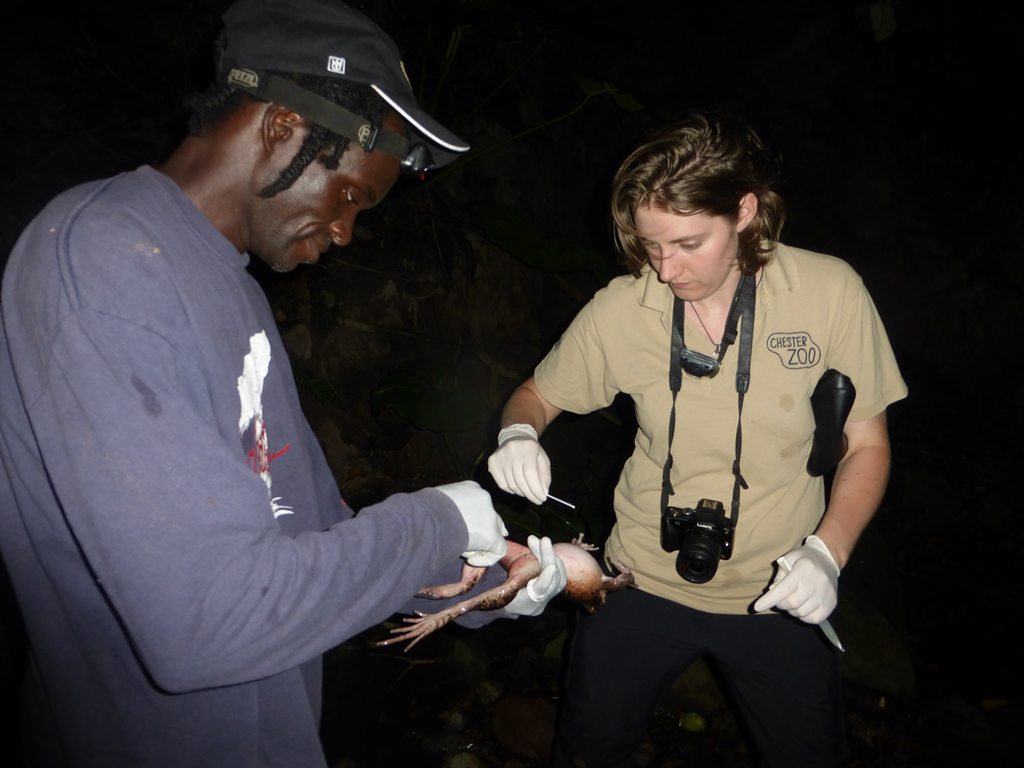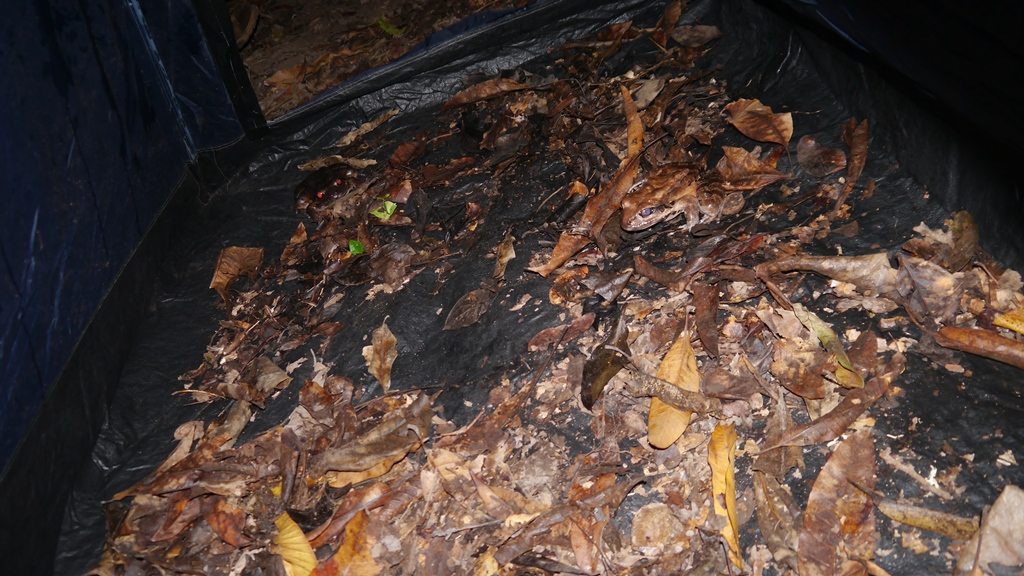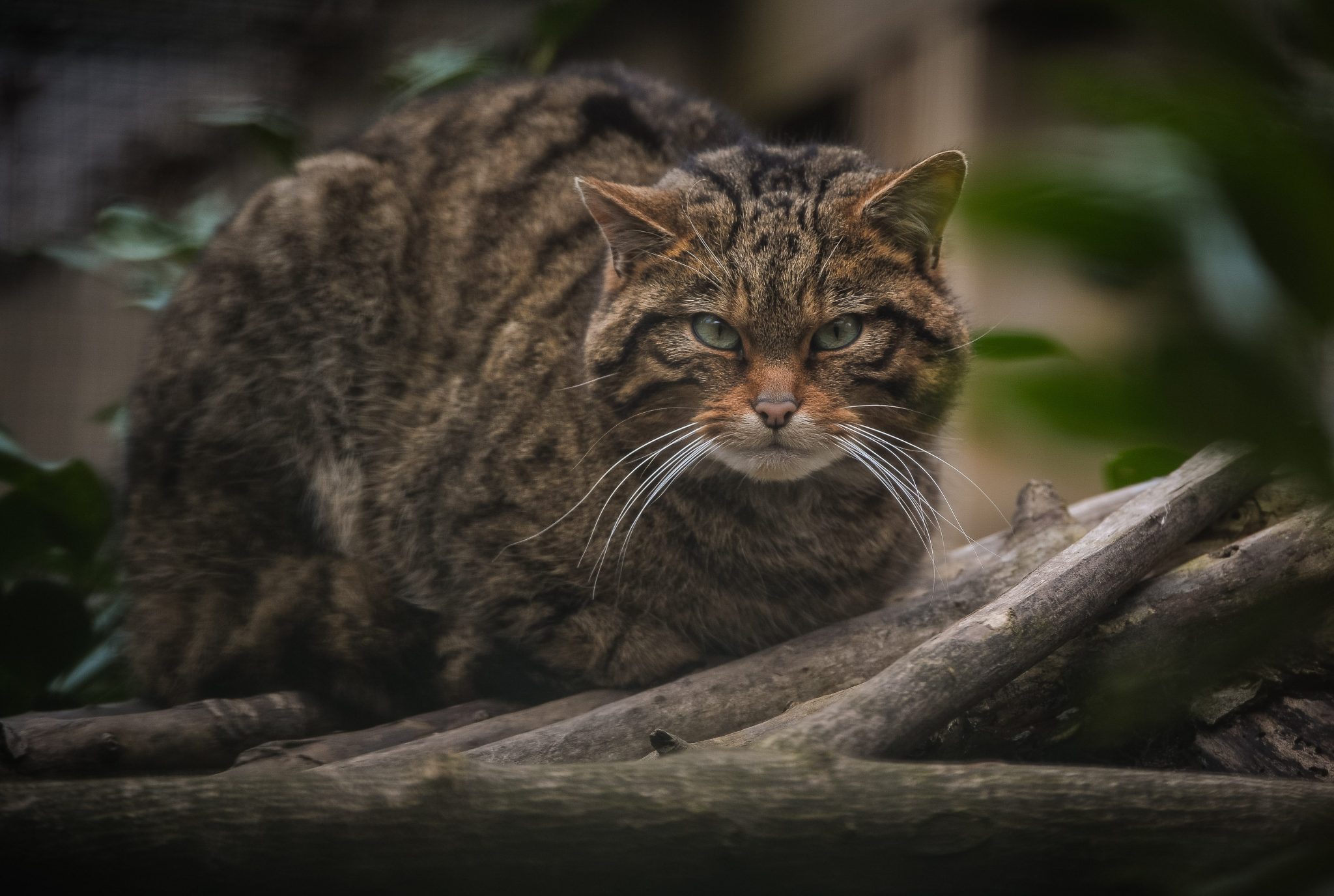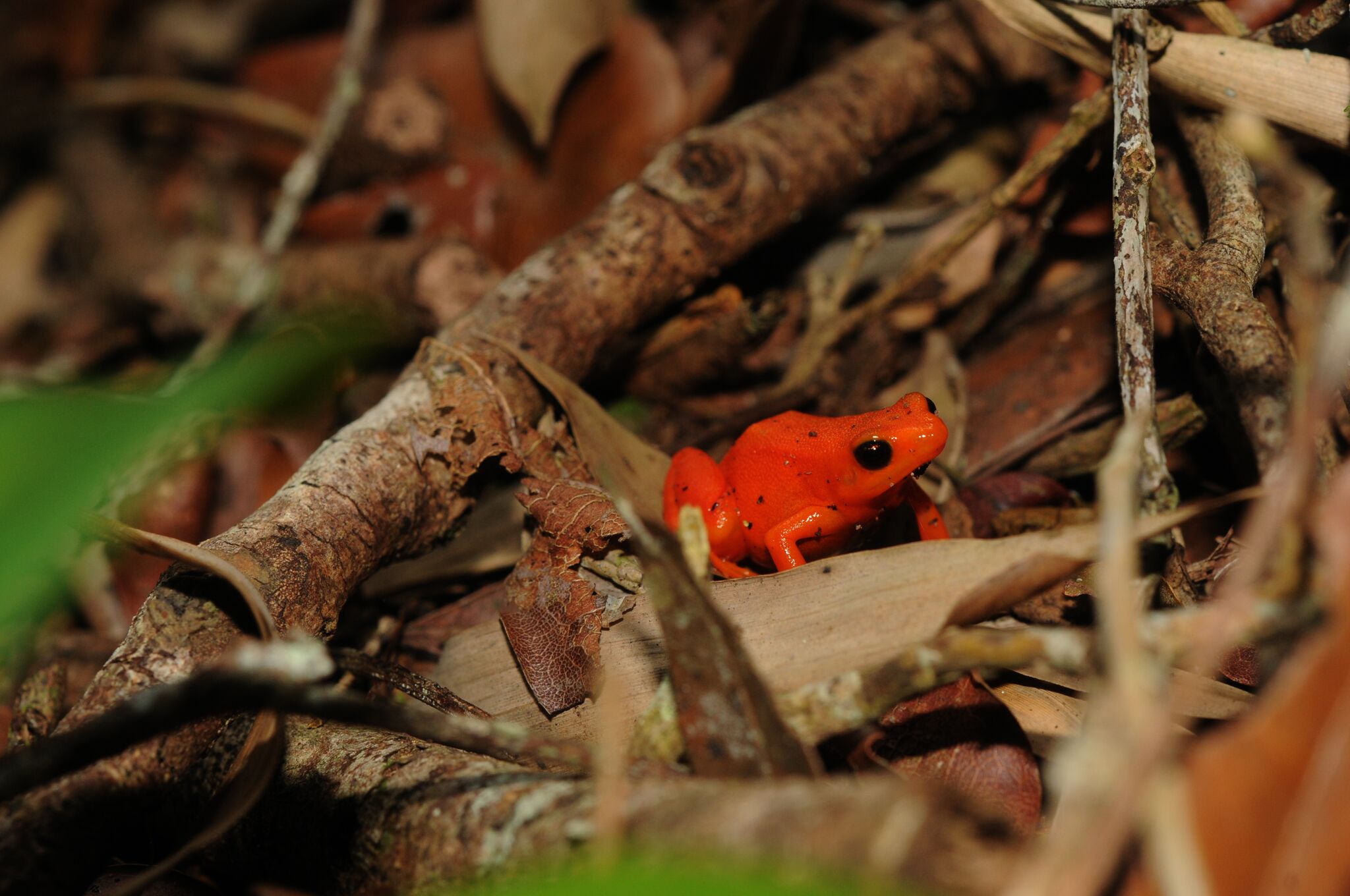Tag: Protecting animal populations
We’re working tirelessly at the zoo and with our partners in the field to do all we can to try and save the species before it disappears forever. We started the first ever European conservation breeding programme for the Javan green magpie in December last year.
Only a small number of mountain chicken frogs remain on just two islands, Dominica and Montserrat. On the island of Montserrat there are just two individuals left – one male and one female. A field trip to reunite these two remaining wild mountain chicken frogs recently took place, and Katy Upton, Chester Zoo’s lower vertebrates and invertebrates curatorial assistant, was one of the team members. Here she tells us more about their mission:
“I landed in Montserrat at around 6pm on a warm humid evening where I was met by Jeff Dawson, Durrell’s Amphibian Programme Manager, who took me to my guest house. That first drive along winding roads, navigating steep sided ghauts (a deep valley between two mountains) with an overwhelming smell of mangos was a sensory overload and something I will never forget! Montserrat is a magical place, untouched by tourism, with perfect Caribbean weather yet in the shadow of an active volcano which years before destroyed the old capital city. After that first night’s sleep I was ready to get out in the field, and find the frogs.
The aim of this trip was to translocate the last female mountain chicken on Montserrat into the range of the last male.
“In the start of June this year, these two remaining frogs were found; after nearly a year of no sightings. Although this was great news, the frogs had been sighted at totally separate locations so the next step was to move them together. I joined colleagues from Durrell (Jeff Dawson), ZSL (Luke Harding & Stephanie Jayson) and the Montserrat Department of Environment (Blacka & Lloydie) to make this translocation a reality…
“I am pretty sure I was the good luck charm they needed as on my very first night, we found both frogs! Jeff had been there nine days and Luke a few days searching every night. It was a very long hike into the start of Fairy Walk; the ghaut where the last two frogs live which coincidently is within the volcano exclusion zone. That first walk into Fairy Walk was exhausting, navigating steep sided ghauts, avoiding donkeys – yes donkeys – and dealing with the heat and humidity was not easy but totally worth it. We needed to wait until total darkness which adds another element of difficulty when searching however, after only 30 minutes Blacka found the female.
It was amazing and heartbreaking to see my very first wild mountain chicken and realise quite how alone she is.
“We caught her and scanned her pit tag to ensure she was the correct frog then recorded her biometrics – weight, snout-vent length, leg length and body temperature. After this we carefully moved her, in a cloth bag to minimise stress, down to the male’s location some 700m down the ghaut.
“Once we arrived at the release site we had a quick search for the male. To search for a mountain chicken in total darkness, you look for their eye shine reflecting your torch light; a mountain chicken’s eye shine is redder than a cane toad (the only other frog you could mistake them for). I spotted quite a bit of eye shine then suddenly saw one which look different I tried to supresses my excitement as I moved closer and yes! There he was, perched a metre above the stream sitting within a clump of exposed roots. We caught him and collected the same data as the female. We then set up a small tent with a leaf litter substrate and left the two frogs within the tent for a short period of time. Eventually we slowly opened the tent and backed away to allow them to exit. We sat some way down the path to give them some space and whilst sitting in the dark we could hear them in the distance making contact calls to each other.
“I felt incredibly lucky and hopeful to hear the last two mountain chickens in Montserrat calling to one another.
“We snuck back to the release site 45 minutes later and we found both frogs out together sitting on the forest floor. Feeling hopeful, we packed up the equipment and left them alone.
“The very next night we were out again eager to see if the female had stayed with the male or attempted to move back to her previous territory. When we arrived at the site I decided to walk up the bank to search for the frogs as it seemed like a good place to start; turns out it was! Within a few minutes I had located the male sitting at the top, in a prime calling position. Not long after, Luke found the female about 20 meters from the male right down in the ghaut by a group of large boulders. These boulders have a great potential for egg laying sites as the frogs can excavate large chambers for nest building beneath them. It was great to find both frogs again and know the female had stayed that first night.
“We continued to monitor the frogs over the following days however we only found the male on a few occasions and didn’t see the female again. We began to worry she may have moved back to her old range so we continued searching up the ghaut and back to her original territory without any luck. Six days later, after nights which were too hot or too wet and only finding the male, we finally found her. We searched for over an hour occasionally sitting back down and waiting in the hope she would come out of hiding. We were about to give up hope when I spotted her. She was sitting in the stream right out in the open; she looked great, really healthy and obviously had no intention of leaving the area as she was less than five metres from where we originally released her!
“The next night was my final night, I was flying out the following day but I was determined to go back one last time and see the frogs! We found the male very quickly but a long search for the female proved fruitless, however, we were fairly confident she was still there (and searches since have confirmed this). It would have been nice to see her one last time, but I was happy knowing we had achieved our goal of moving these last two frogs together.
“My two weeks in Montserrat were over so quickly and I hope that one day I will return to see many mountain chickens in the forest and the sound of males calling across the valleys. But for now I will settle for one clutch of juvenile frogs, fingers crossed our matchmaking worked!”
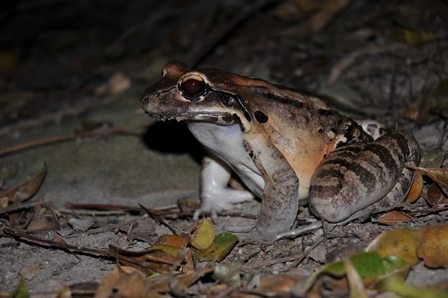
Donate to our amphibian projects and 100% of your money will be used to help save amphibians in the wild.
It is however a sad reality that without the tireless conservation efforts of field rangers and conservationists this experience would soon be an impossible one. In addition to supporting field conservation projects, Chester Zoo works to ensure that zoo populations of black rhino are sustainable, so that they can fulfil their role as ‘insurance’ populations away from the threats faced in the wild.
Unfortunately, breeding black rhinos is not easy, and many rhinos fail to breed. For her PhD research, Katie Edwards (University of Liverpool) along with applied science staff at Chester Zoo wanted to improve the situation, and by using faecal hormone analyses we have been able to improve the breeding success of these magnificent animals. We are also beginning to understand what other factors may affect breeding success. You can find out more about our work with the rhinos here.
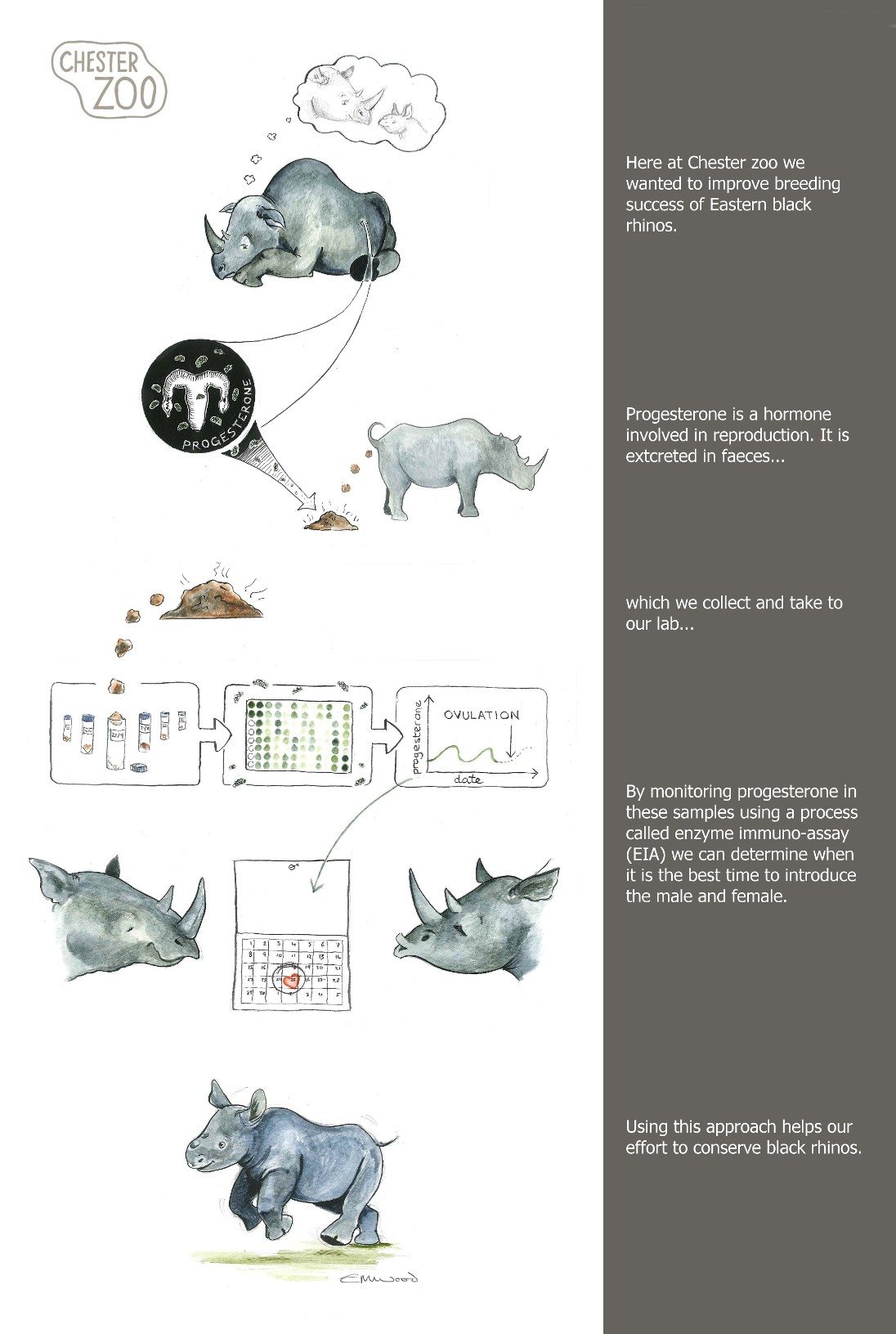
Rhino illustration by Emma Wood
By using techniques we have developed in the zoo, we are now working with Nick Harvey (University of Manchester) for his PhD research will try to understand what may be constraining reproduction in wild black rhinos in Kenya.
These magnificent birds are related to emus and ostriches. And for such a large bird, cassowaries are known to be elusive, and potentially dangerous, in the tropical rainforests of South East Asia and Australia. Unfortunately, the species is declining and classified as vulnerable by the IUCN. At Chester Zoo we have two southern cassowaries which have recently been moved to our new Islands habitat.
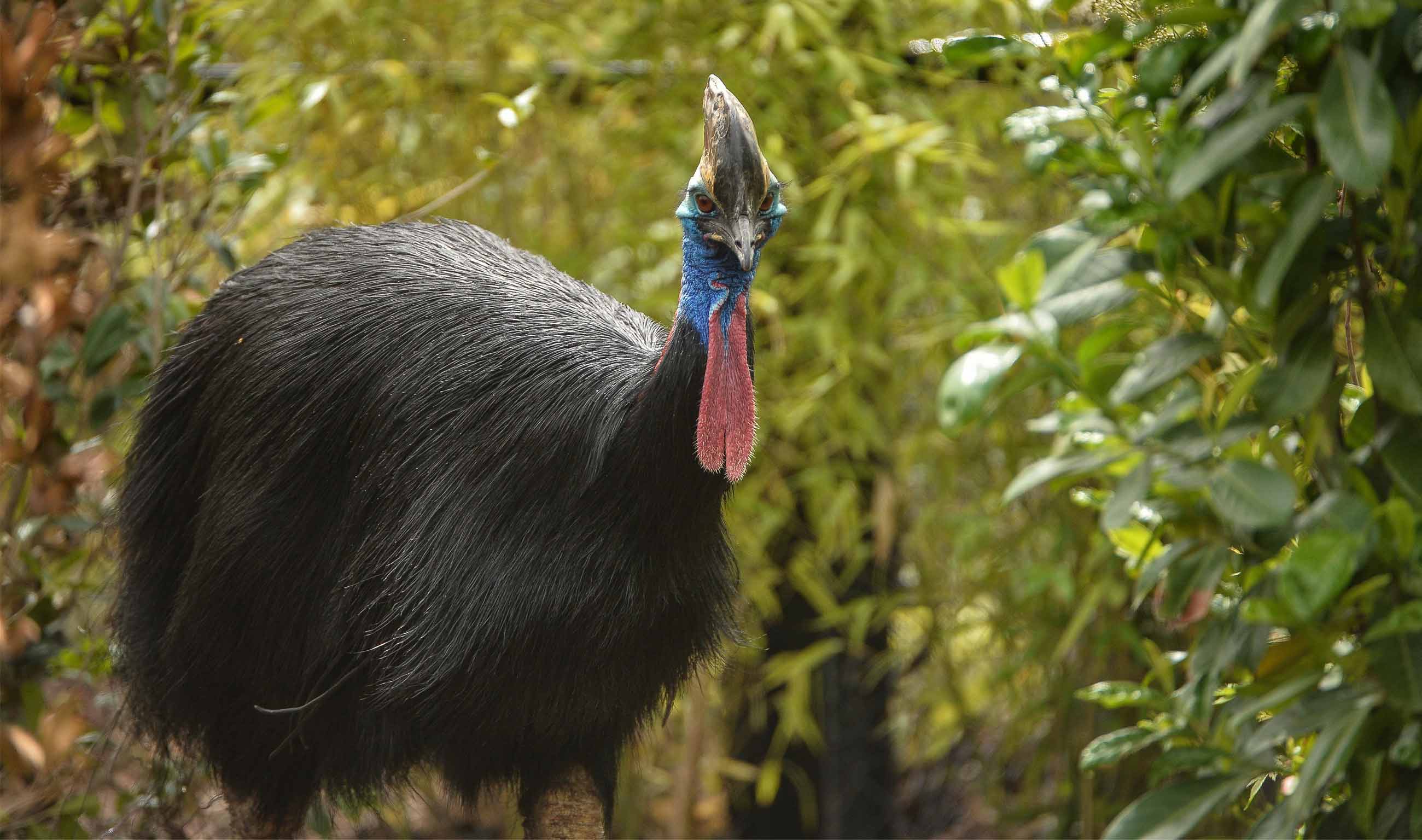
Chester Zoo bird keeper, Zoe Sweetman, tells us more about these birds:
“The first thing you notice about the cassowary is their dinosaurlike features, they started to evolve over 60 million years ago during the Cretaceous period and they are still a very big intimidating bird. Cassowaries use a series of low frequency booms and calls to communicate. These signal their territories and breeding susceptibility, as well as many other things which we simply do not understand.
I find the subtle way in which they communicate with one another through body language very interesting indeed. The gentle head bobs and body brushes observed between our male and female are almost romantic and watching such a large and powerful bird behave in this elegant manner is absolutely fascinating.
“Although cassowaries are a shy and secretive bird, they can become very aggressive if they feel threatened. They have a long claw on the inside toe which they use to kick out and injure any potential threat including humans. This means that they are classified as a ‘category red’ species, so we can’t go in with them but our new enclosure has been fitted with lots of cameras giving us a brilliant insight into the cassowaries behaviour.
“Cassowaries are primarily a solitary species, however, it has always been our aim to try and introduce our pair. As cassowaries are notoriously difficult to mix, we needed to be able to watch their behaviour and body language towards one another for several weeks before we risked putting them together.
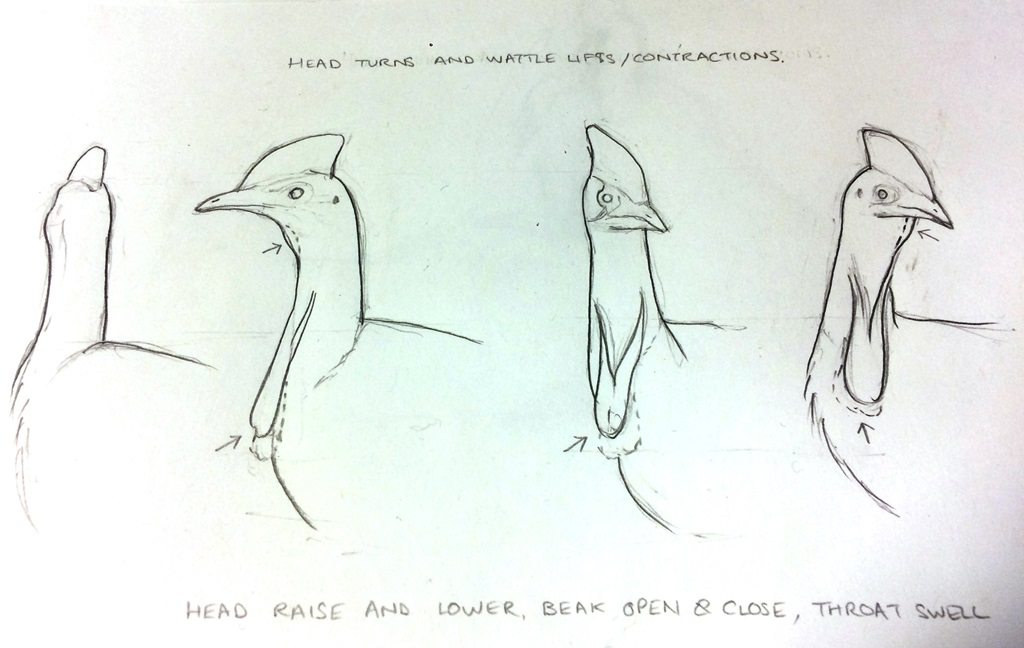

“Working alongside applied science staff at Chester Zoo the cassowary keepers have been investigating their breeding behaviour after they were mixed for the first time. Very little is documented about their behaviour and we are trying to change that. Using CCTV footage our scientists have been monitoring them and, for the first time, their reproductive hormones from faecal samples have been analysed in Chester Zoo’s endocrinology laboratory. We are planning to expand this research further by recording their low frequency booms and calls, some of which we believe are outside human hearing.”
Our amphibian programme focuses on the most endangered vertebrate group in the animal kingdom, with more than a third of the 6600 known species threatened with extinction. Addressing their extinction crisis is thought to be one of the greatest conservation challenges ever faced but it is something we’re attempting to tackle by working closely with our partners.
A high priority for us is the protection of one particular amphibious species; the critically endangered mountain chicken frog. It is estimated that there is less than 50 individuals left on the Caribbean islands of Montserrat and Dominica.
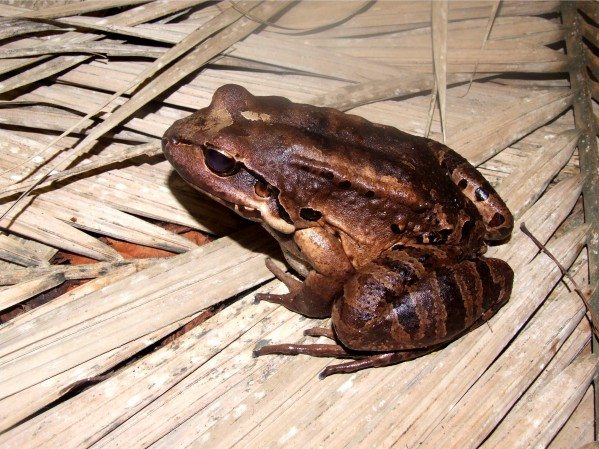
Similarly to many amphibian species around the globe, the fungal disease chytridmycosis is one of the main threats to the mountain chicken frog – there is currently no cure and it is very difficult to control its spread. The mountain chicken is also seriously threatened by their use as a food source for local people.
We are part of an international campaign which aims to save this species and build up numbers on these islands before it’s too late. We are working on both in-situ and ex-situ projects, including a breeding and research programme, trialling the release of young adult frogs onto the island of Montserrat.
We are also the coordinator of the captive management population of this species and are working with universities and conservation scientists to carry out research, much of which is done in specially built laboratories here at the zoo.
Unfortunately, the population numbers are currently worrying low and as a result we hosted a critical meeting to discuss the long-term management plan for the mountain chicken.
Facilitated by Kristine Schad, population biologist for the European Association of Zoos and Aquaria (EAZA), we welcomed a number of conservation scientists with the aim of setting roles and goals to ensure that the population gets back on track.
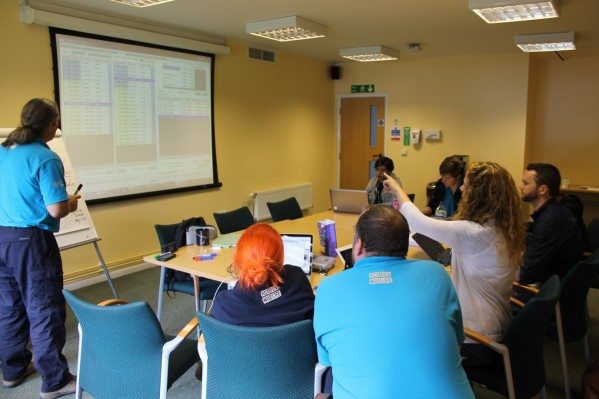
Other participants include our curator of lower vertebrates and invertebrates, Gerardo Garcia, Ben Baker, Pip Carter-Jones and Katie Upton from Chester Zoo, Benjamin Tapley from ZSL, Matthias Goetz, Durrell Zoo and Natalia D’Souza, Durrell Institute of Conservation and Ecology at the University of Kent.
We’ll keep you up to date with the project and any future developments resulting from the meeting.
Last year we joined forces with The Vincent Wildlife Trust on their Pine Marten Recovery Project. So far, the project has gone from strength to strength with the most recent news from the project being the arrival of kitsto some of the females that had been translocated.
These little snippets of information give us a rough idea of what the pine martens have been getting up to in their first year after arriving in Wales.
One marten in particular seemed to be easier to follow than the rest, mainly owing to her prominent personality. The Vincent Wildlife Trust named her Miss Piggy and we will be bringing you exclusive updates about Miss Piggy from the field. Josie Bridges, Pine Marten Project Field Assistant for The Vincent Wildlife Trust, tells us more about what Miss Piggy’s life in Wales has looked like so far:
“Miss Piggy (PM07) arrived in Wales in October 2015, along with another female and a male. All three were driven from Scotland overnight and it is from this journey that PM07 received her very fitting name. The van transporting the martens regularly stops to offer the animals food and water, and whilst some of the animals can be very wary of people and will only eat once left alone, this was not the case with Miss Piggy!
“On arrival in Wales, Miss Piggy was released into a pen built by a team from Chester Zoo. Remote cameras in each pen monitor the behaviour of the martens to assess whether they are stressed and if they are eating regularly. Initially, most of the animals have a period where they hide in their pen’s den box, only venturing out into the pen in search of food under cover of darkness. Miss Piggy had no such reservations and was out and about in her pen within a few hours hunting out any available food.
“After about six days, the doors to the pens are opened to allow the martens to roam free. The pens are left in situ to allow the animals to return after release for supplementary feeding and a safe shelter while they establish a territory. For some time Miss Piggy, unlike most of the other martens, regularly returned to her pen to sleep and to hoover up any food left by project staff – her antics frequently captured on camera. She became well known for the ‘reverse egg wiggle’, deftly rolling an egg backwards!
“All the martens were radio tracked daily to check on their whereabouts – and this has continued until this month. The animals are now being recaptured and the radio collars removed. True to form Miss Piggy was captured having eaten everything in her trap. From this point on only remote cameras and scats (droppings) will tell us of her whereabouts as she settles into life in Wales. Next year she will be old enough to have kits – we keep our fingers crossed.”
If you want more detail about how Miss Piggy’s life in Wales is going, then head over to The Vincent Wildlife Trust’s website here. Keep your eyes peeled as we follow Miss Piggy closely over the coming years and keep our fingers crossed that she joins the breeding population of pine martens in the years to come.
You can help us continue to protect the precious wildlife right here in the UK by making a donation to Act for Wildlife today. 100% of your money will go towards projects working to protect Britain’s rarest animals like the pine marten.
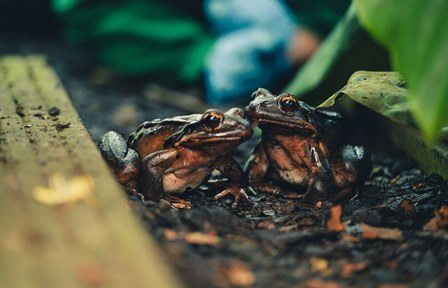
We’re working in collaboration with other zoos to help save this critically endangered species through a breeding programme before it’s too late; the first of its kind to focus on amphibians.
Twenty four frogs have been carefully matched together using detailed genetic information in a new breeding effort which is seen as the last hope for the long-term survival of the species.
Together with Zoological Society of London (ZSL) and Durrell Wildlife Conservation Trust in the UK and Norden Ark in Sweden, we aim to ensure a genetically viable population of the frogs kept in bio-secure conditions which, one day, could see them reintroduced into the wild.
Only a small number of wild mountain chicken frogs remain on just two islands, Dominica and Montserrat – with Montserrat now home to just two individuals, one male and one female!
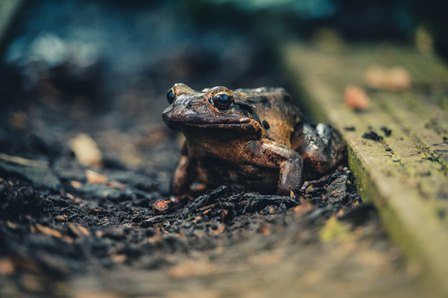
Dr Gerardo Garcia, curator of lower vertebrates and invertebrates at Chester Zoo and studbook holder for the mountain chicken breeding programme, tells us more below:
“Essentially we’ve created a dating agency for one of the largest and most endangered frog species in the world. Based on genetic evidence and DNA sampling we’ve matched together the best pairs of mountain chicken frogs from the four institutions in Europe that work with them – to try and breed the most genetically viable population of the frogs that we possibly can.
“Our ultimate aim is to reintroduce these wonderful animals back into the wild where, sadly, their numbers have been completely decimated. To do that we need a long-term sustainable breeding programme and this is the first and only European Endangered Species Programme (EEP) for an amphibian, so it’s a real landmark plan that we’ve developed. The frogs are spiralling closer and closer to extinction – so it really is do or die for them.
“Protecting mountain chicken frogs is incredibly important to conservationists. These frogs are the top terrestrial predator on the Caribbean islands where they live and crucial to the control of pests and insects. They have a key role in the eco-system and their disappearance could potentially have an impact on crops and, subsequently, livelihoods. These frogs have also always been culturally important to the islands.
“Mountain chickens are incredibly charismatic and there’s no other species that’s like them. However, what we’re doing to try and protect them is not just about this species, as what is learnt here can be applied to others in the future. Right now we have no idea just how valuable this work could be.”
Population biologist at the European Association of Zoos and Aquaria (EAZA), Kristine Schad, said:
“This spectacular species is on the very brink of extinction, so the skills in the zoo community represent one of the last chances for its survival. The creation of a monitoring breeding programme for the mountain chicken frog is hugely important if we are to avert disaster for the species.”
We’re also working with a number of universities and researchers to carry out studies on the species, much of which is done in in three purpose-built labs at Chester Zoo. To find out more about the work we’re doing with mountain chickens, read some of our previous blogs here.
To help us continue our vital work to stop this animal from going extinct, please make an online donation here – or text ‘AMPH18 £5′ to 70070 to donate £5 to our amphibian programme.
- £5 will feed the mountain chicken frogs at the zoo for one day
- £30 will buy a portable pool for baby frogs
- £100 will fund a rearing room for mountain chicken babies – fingers crossed we’ll need these in the near future!
(JustTextGiving by Vodafone. For full T&C’s please visit Just Giving)
The black poplar is one of the most endangered native trees in Britain. Approximately 300 individuals grow in Cheshire but they are mostly old trees that are not regenerating naturally.
Over 1,000 new trees, raised from cuttings of Cheshire poplars, have been planted into suitable sites in the county since 1995 in an attempt to save this species from disappearing from the county. The staff here at Chester Zoo have participated in this propagation work for just over a decade.
Propagation is a lengthy process and our botanics team here at the zoo work hard year round to make sure the cuttings grow into strong and healthy trees that are ready to be planted back into the wild. The winter months are the best time to start taking cuttings for propagation. Richard Hewitt, Chester Zoo’s horticulturist team manager, explains the propagation process in more detail, below:
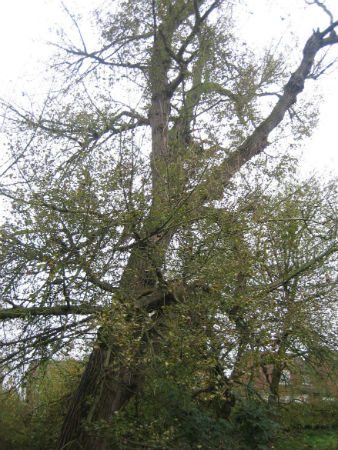
One of Cheshire’s black poplar trees.
Cuttings are taken from the end of a branch of a mature tree. New shoots will grow around where the cutting has been taken.
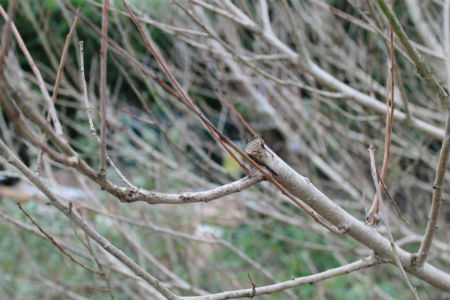
One of the branches that was cut during last year’s propagation process. You can see new growth has started around the area that has been cut.
The cutting is then tidied up and shaped so that the cutting will grow. One end should have a diagonal cut and the other should be flat, indicating which way up the cutting should be planted.
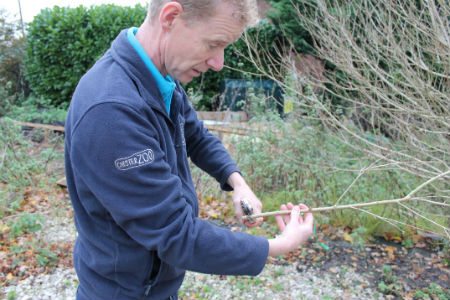
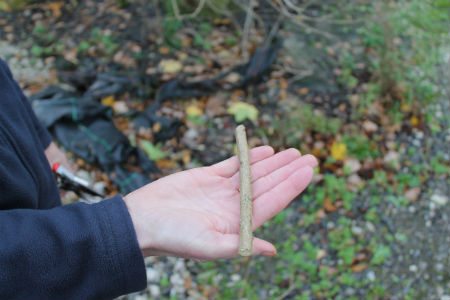
This cutting is now ready to be planted. You can just about make out the diagonal cut at the top end of the cutting and the flat end at the bottom.
The cuttings are then taken back to the nursery where the bottoms are rolled in a plant hormone powder to encourage growth of roots, and put in pots.
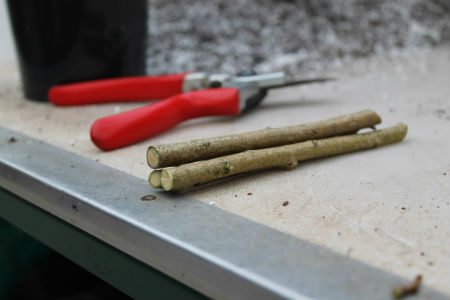
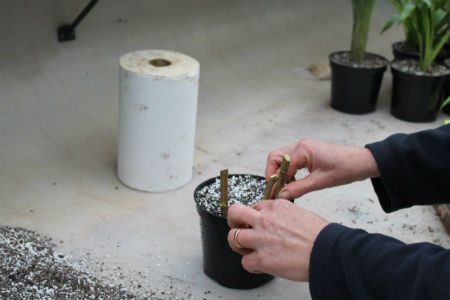
Cuttings ready to be potted.
At first, the potted cuttings spend some time outside during the colder months to replicate the same conditions that the whole tree would be experiencing. This is to ensure that the cuttings’ growth cycle stays in sync with the natural season.
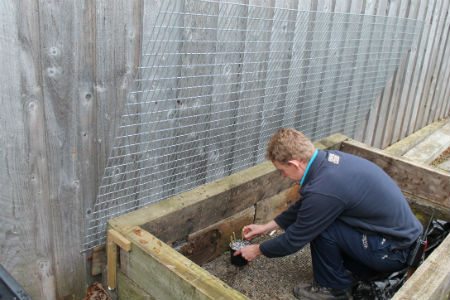
The freshly potted cuttings going into their out-door pen.
When the cuttings have taken root they start to grow upwards and begin to resemble saplings, and they are moved indoors. The greenhouse they are kept in has no heating system so it again mimics the natural seasonal temperatures, it just provides protection from the wind and rain.
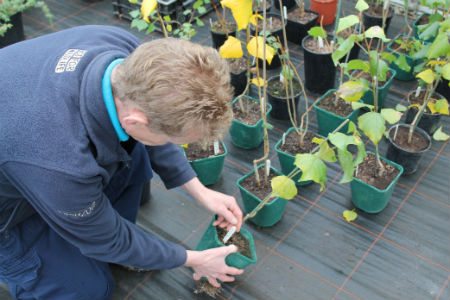
Richard checking on the saplings that have been moved indoors.
Eventually, the trees get too big to be housed indoors and they are re-potted into bigger pots, so they can develop the extensive root network they will need. They are moved outside where the horticultural team can keep a close eye on them.
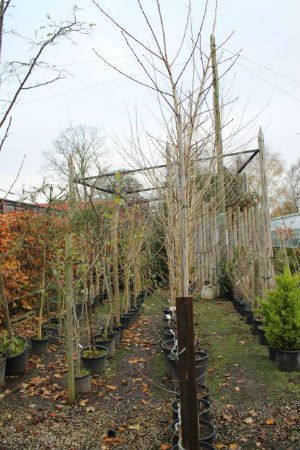
Rows and rows of Black poplar trees. The biggest ones here are 2 years old.
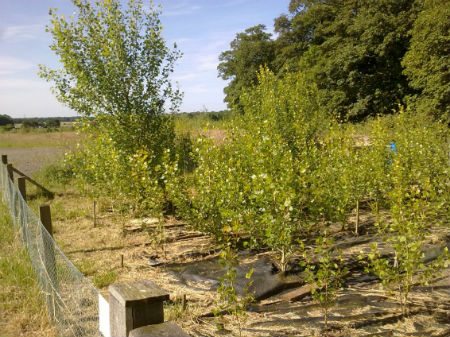
Trees planted out of the zoo to flourish further.
Finally, once the trees are big enough, they are taken and planted out to thrive into beautiful and healthy trees. Discover more about the work we do at the zoo here.
In our previous update from our project partners, The Vincent Wildlife Trust, back in September 2015, we told you about the translocation of native pine martens from Scotland to Wales as part of Britain’s first carnivore recovery scheme.
It’s official, following the move pine marten kits have been born in Wales! And we’re extremely happy to hear this news; these births are a significant moment in the conservation of pine martens as this native mammal carries the title of Britain’s second rarest carnivore, after the wildcat.
At least three of the ten female pine martens brought to Wales from Scotland last autumn by The Vincent Wildlife Trust have given birth. Staff from the Trust’s ‘Pine Marten Recovery Project’ placed remote cameras at a number of sites where they believed female martens were preparing to have young.
Further investigation has confirmed a total of at least five kits! Natile Buttriss, CEO of The Vincent Wildlife Trust, said:
“I am absolutely delighted. We have been waiting with bated breath for months to see if breeding would be successful.”
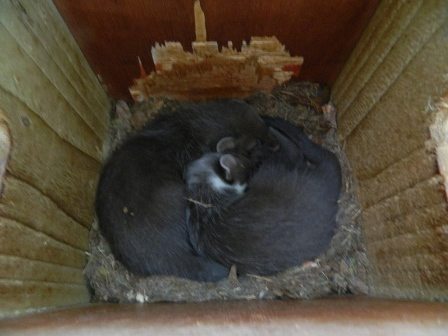
The Pine Marten Recovery Project aims to restore a viable pine marten population to Wales and England. We are one of the project’s major partners, as well as the People’s Trust for Endangered Species (PTES) and Woodland Trust, with support from Wildlife Vets International and Exeter University.
This is such amazing news, and makes all the hard work by the Vincent Wildlife Trust team and partners worthwhile.
Mike Townsend of the Woodland Trust added:
“Pine martens are not just an iconic woodland species, but also a key missing element in the woodland ecosystem. This recovery project demonstrates the importance of ensuring connectivity of good wildlife habitats across wide areas, so this beautiful and rare creature can thrive and hopefully spread more widely across the country.”
In September twenty pine martens were taken from Forestry Commission Scotland land under licence from Scottish Natural Heritage and relocated to Wales where they were on the verge of extinction. The animals were released in woodland owned by Natural Resources Wales.
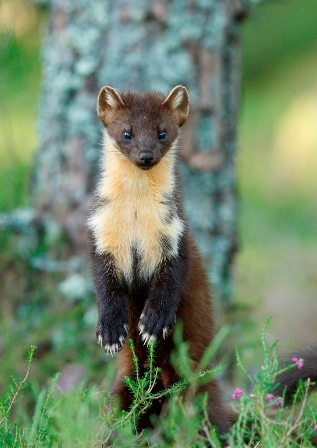
This is a pilot project and the animals have been radio tracked daily by staff and local volunteers to monitor their movements and behaviour patterns. When some of the females’ behaviour began to change it was a sign that a birth might be imminent.
A further twenty pine martens will be translocated from Scotland in the autumn and this should result in a self-sustaining population that over time will spread to other forests of Wales and across the border into England. Without this helping hand, it is likely that this native mammal would simply disappear from the Welsh landscape.
You can support the conservation work we do right here in the UK by making a donation to our UK Wildlife programme, here. Thanks to your support we’re able to continue working with projects like The Vincent Wildlife Trust and protect the precious wildlife found right on our doorstep before we lose them forever.
